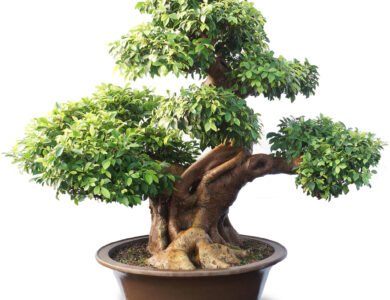
care for Ficus retusa, also known as the Ginseng Ficus or Ficus microcarpa, is a popular indoor plant due to its striking appearance and easy care requirements. With its unique, knobby aerial roots, glossy green leaves, and compact growth habit, the Ginseng Ficus has become a favorite among plant enthusiasts, especially those interested in bonsai cultivation. If you’re looking to grow and care for a Ficus retusa, this guide will provide you with all the essential tips to ensure your plant thrives.
Light Requirements for Ficus Retusa
Ficus retusa requires bright, indirect light to thrive. While it can tolerate some direct sunlight, too much can lead to leaf burn, so it’s best to place it in a spot with filtered sunlight. A south or east-facing window is ideal for indoor cultivation. If your Ficus retusa is placed in a spot with too little light, it may become leggy, with sparse leaves. If you’re growing it as a bonsai, adequate light is essential for maintaining a compact and healthy shape.
Watering Ficus Retusa
One of the most critical aspects of Ficus retusa care is watering. This plant prefers consistent moisture, but it is essential to avoid overwatering. Ficus retusa doesn’t like standing water around its roots, as this can lead to root rot.
Here are some essential tips for watering:
- Water when the top 1-2 inches of soil feel dry. Always check the moisture level before watering again.
- Ensure good drainage. Plant your Ficus retusa in a pot with drainage holes to allow excess water to escape.
- During the growing season (spring and summer), water more frequently, but reduce watering in the winter when the plant’s growth slows.
- Avoid letting the plant sit in water for extended periods, as this can suffocate the roots.
Temperature and Humidity Needs
Ficus retusa thrives in warm conditions and prefers moderate humidity. It does well in temperatures between 60-80°F (16-27°C), making it ideal for indoor spaces. However, it is sensitive to cold temperatures and should not be exposed to drafts or placed in areas with temperatures below 50°F (10°C).
To improve humidity, consider the following:
- Place your plant on a humidity tray filled with pebbles and water to raise moisture levels around the plant.
- Use a humidifier if your home tends to be dry, especially during the winter months.
- Regular misting is another option to maintain a higher humidity level, but avoid excessive moisture on the leaves, as this can lead to fungal issues.
Soil and Fertilization
Ficus retusa prefers well-draining soil, ideally a mix formulated for bonsai trees or indoor plants. A loamy mix with added sand or perlite ensures that water drains well but also retains enough moisture for the plant’s roots to absorb.
For fertilization:
- During the growing season, feed your Ficus retusa with a balanced liquid fertilizer every 4-6 weeks to promote healthy growth.
- Reduce fertilization in the winter when the plant’s growth slows, as over-fertilizing during the dormant period can lead to stress or nutrient imbalances.
- Always use a water-soluble fertilizer with a balanced ratio of nitrogen, phosphorus, and potassium for optimal growth.
Pruning and Shaping Ficus Retusa
Pruning is crucial for maintaining the shape and health of your Ficus retusa, especially if you’re growing it as a bonsai. Regular pruning encourages dense foliage and helps the plant maintain a compact form.
Here are some tips for pruning Ficus retusa:
- Prune regularly to maintain its shape. This will also prevent the plant from becoming too leggy.
- Pinch back the new growth to encourage branching, which helps the plant maintain a bushier, fuller appearance.
- Use clean, sharp scissors or pruning shears to remove dead or damaged leaves or stems, promoting overall plant health.
If you’re growing Ficus retusa as a bonsai, you can also employ wiring techniques to shape the branches and trunk over time. This is a great way to control the tree’s form and design it into a miniature tree with a more sculptural appearance.
Repotting Ficus Retusa
As your Ficus retusa grows, it will eventually need repotting. Typically, repotting should be done every 1-2 years, depending on the plant’s growth rate and the size of the pot.
Here’s how to repot Ficus retusa:
- Choose a pot that’s slightly larger than the current one, with adequate drainage holes.
- Gently remove the plant from its old pot and trim any excess or tangled roots to prevent root rot.
- Fill the new pot with fresh, well-draining soil, and position the Ficus retusa in the center.
- Water thoroughly after repotting to help the plant adjust to its new home.
Common Problems and Solutions
Yellowing Leaves: This can be caused by overwatering, poor drainage, or a lack of nutrients. Ensure the plant is in well-draining soil and check for any root rot.
Leaf Drop: Ficus retusa can drop leaves if it’s moved to a new location or exposed to sudden changes in temperature. Try to maintain consistent care and avoid drastic changes in the environment.
Pests: While Ficus retusa is generally pest-resistant, it can sometimes attract common houseplant pests such as aphids, mealybugs, or spider mites. Regularly inspect your plant and treat any infestations with insecticidal soap or neem oil.
Conclusion
Caring for Ficus retusa is relatively straightforward, making it an excellent choice for indoor plant lovers, especially those interested in bonsai cultivation. With proper attention to watering, lighting, humidity, and pruning, your Ficus retusa can thrive and become a beautiful addition to your home. Whether you’re a seasoned gardener or just starting, this resilient plant will reward you with lush, glossy leaves and unique roots that add a touch of natural elegance to any space.

